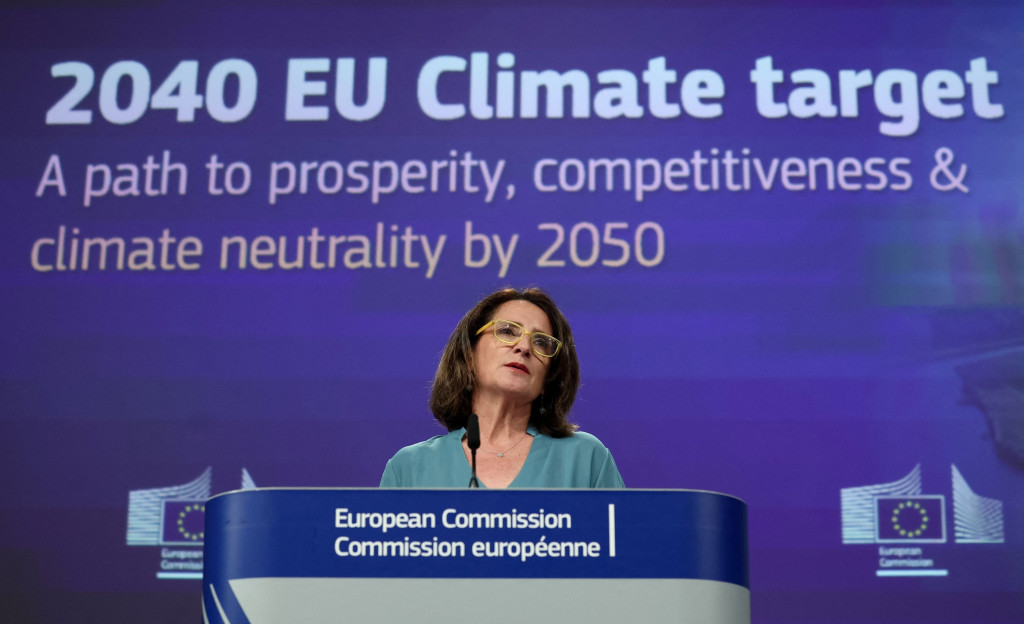Reading Time: 5min

On 2nd July 2025, the European Commission presented its proposal for the EU’s 2040 climate target as well as for the revision of the European Climate Law.
The draft foresees a 90% reduction in net greenhouse gas emissions compared to 1990 levels. This is a key milestone on the EU’s path to achieving climate neutrality by 2050.

Source: Climate Action Tracker
The proposal comes on the basis of a comprehensive impact assessment and guidance provided by the Intergovernmental Panel on Climate Change (IPCC) as well as the European Scientific Advisory Board (EASB) on Climate Change.
The 2040 target is strategic as it guides key investment decisions and will inform the EU’s future post-2030 Nationally Determined Contribution (NDC) that all Parties must submit to the UNFCCC by 2025 as part of the Paris Agreement (under Article 4).
The Commission is proposing the use of high-quality international carbon credits - up to 3% of 1990 EU net emissions - towards 2040’s EU Climate Targets, starting in 2036.
These credits should be:
Excluded from EU ETS Compliance
Coming from Paris-aligned activities
Support developing countries# net zero pathways
Using high quality quantification standards
The 2040 climate target proposed by the Commission is being considered by the European Parliament and the Council within the ordinary legislative procedure. The agreed target will provide a benchmark for the EU’s policy framework beyond 2030.
Additionally, the Commission will cooperate with the Council Presidency to conclude the EU’s Nationally Determined Contribution (NDC) communication for COP 30.
If the credit use increases linearly from 0% in 2036 to 3% by 2040, the EU could consume approximately 347.6 million tonnes of carbon credits over the five-year period. The use until 2050 is forecasted up to 1Gt CO2e.
Between 2008 and 2020, the EU allowed companies to use international credits under the ETS. Over 1.6 billion credits were used. Many of these credits came from the Clean Development Mechanism (CDM) and Joint Implementation (JI) systems under the Kyoto Protocol.
However, this system had problems, and the EU stopped accepting international credits after 2020. The current rules for the EU ETS focus only on domestic actions. This is where the Article 6 of the Paris Agreement comes into effect.
The Öko-Institute has published a detailed Policy Brief „Conditions for Using International Carbon Credits towards the EU’s 2040 Climate Target“. We recommend reading it here.
The lawmaker leading the European Parliament's work on this new EU climate milestone, a member of the European Parliament with the far-right Patriots for Europe, filed in July 2025 a motion rejecting the entire proposal of the 2040 climate targets.
Despite the motion's low probability of success, thanks to the political alignment among centrists, liberals, and left-leaning parties, it highlights the contentious and highly debated nature of the EU's 2040 climate policy.
Regarding the use of international carbon credits as part of the goals, EU Commissioner for Climate, Net Zero and Clean Growth, Wopke Hoekstra, recently defended this proposal, which she sees as an opportunity to “build bridges” with Africa and Latin America.
However, on August 29th the industry committee of the EU Parliament (ITRE) rejected this idea, emphasizing that the EU should reach its target through domestic efforts.
The Danish EU Presidency currently holding the European Council proposed that ministers would vote on the 2040 target on 18 September, during an environment Council.
But the EU official said that Member States were not yet ready and the matter will be pushed back to be discussed and agreed by EU heads of state during an October summit.
To be continued.
The European Commission's proposal for a 90% net greenhouse gas emission reduction by 2040 marks a pivotal step towards the EU's 2050 climate neutrality goal.
Crucially, this signals the EU's recognition of the need for flexible instruments. This flexibility is vital to achieving our long-term climate objectives without deterring the robust domestic emission reduction efforts already underway through established instruments.
Furthermore, this move underscores that the carbon market is maturing and ready for greater institutionalization with the European Union seriously considering purchasing Article 6-aligned, high-quality international carbon credits.
This development is not only good news for the global climate, by mobilizing finance for critical mitigation efforts in developing countries, but also for companies and investors actively participating in or looking to engage with a more stable and predictable carbon market.
Planet2050 provides early capital to Carbon Avoidance or Removal project developers in exchange for future carbon credits — using a combination of instruments of equity investment, carbon streaming agreements and forward contracts.
Through upfront financing, technical expertise, and close engagement with project developers, Planet2050 is building a high-quality portfolio — and a new infrastructure for the climate economy.
We work with public and private partners globally to identify the best opportunities for impact, get projects off the ground and ensure full integrity along the value chain, from the issuance of carbon credit on international certification standards through transaction and retirements.
Monitoring policy and market development is key to Planet2050, especially related to EU Carbon Policies, in order to ensure our investment decisions are future-proof and aligned with the trend of institutionalization of the nascent carbon removal market.
For investors, this creates exposure to a new climate-linked asset class with long-term growth potential.
Planet2050 plans to make these investments accessible beyond traditional private finance, to a wider public, through an upcoming public listing in Europe.
Learn more at https://planet2050.earth/investors
This was Part #3 of our four-part EU Carbon Policy Series. Check out previous issues:
Part #1 about Germany’s leadership
Part #2 on the UK, Sweden, Dankmark and Switzerland
Or subscribe to Planet2050 at https://planet2050.earth/newsletter to never miss the most important Carbon Market News.